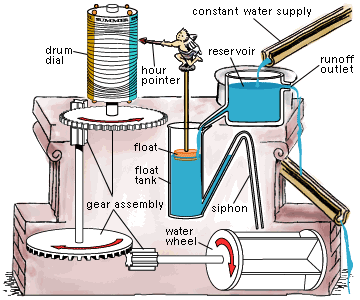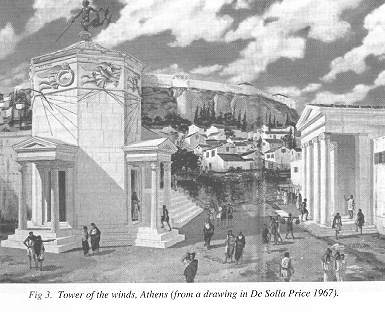Water Clock Experiment
Water Clock Experiment ajlill Fri, 12/05/2008 - 20:32Hook
15 min.
Talk about the history of water clocks. http://en.wikipedia.org/wiki/Water_clock
Relate this to how the Greeks used the water clock to limit debate in public life.
Discuss how the Greeks divided the day into 12 hours, so they changed length as the seasons changed.
Show the Tower of the Winds in the Agora. http://en.wikipedia.org/wiki/Tower_of_the_Winds
Lesson Flow
10 min - Divide the children into groups. Ensure each group has a heterogenous mix of students. Introduce the experiment. List required information to be gathered for the lab report.
30 min - Allow the children to gather data.
5 min - Cleanup.
10 min - Demonstrate how the produce a scatterplot.
30 min - Allow children to do their scatter plot. If they finish early, have them consider the remaining questions on the Experiment sheet.
15 min - Discuss remaining questions as a class.
Teachers Notes:
p = a*h, where a is a constant (density*g) and h is the height of the water column.
Flow = b*p where b is a constant.
So theoretically, they should get a linear graph ending at zero. Realistically, surface tension will mess this up when you get below a couple of cm of water.
Key Questions:
What is a siphon, Why do you need different clocks for different seasons. Why does the sun move north to south.
Water Clock Experiment Recording Sheet
Water Clock Experiment Recording Sheet ajlill Sun, 12/07/2008 - 14:57Name: __________________________________
Purpose
To investigate the relationship between the height of water in a container and how fast if flows out.
Material
- Prepared Water bottle with hole
- Graduated cylinder
- Ruler
- Stopwatch or Wall clock with second hand
Instructions
Repeat the following steps with the bottle starting with different water levels in the bottle. For example, nearly full, half full, and nearly empty. Collect additional data for other water levels as time permits. The more data the better.
- Place your finger over the hole in the bottom of the bottle and pour water in it.
- Keeping your finger over the hole, set the bottle on the edge of a level surface and measure the height of the water from the bottom on the bottle. Record this data.
- Place the graduated cylinder on a level surface so that it will collect the water that runs out of the hole in the bottle and you can see when the water reaches the 100ml mark. Make sure the cylinder is empty before you start.
- Hold the bottle upright over the cylinder.
- If you are using a stopwatch, start it when you take your finger off the hole, and stop it when the water reaches the 100ml line in the cylinder. Record this as the elapsed time. You do not have to fill in the start and stop time.
- If you are using a wall clock, record the time when you take your finger off of the hole, as well as the time when the water reaches the 100ml line in the cylinder, then calculate the elapsed time.
Ruberic (Formative)
Level 4: with thorough detail and accuracy completes the experiment report
Level 3: with considerable detail and accuracy completes the experiment report
Level 2: with some detail and accuracy completes the experiment report
Level 1: with little detail and accuracy completes the experiment report
Observations
| Trial | Water Level | Start time | End time | Elapsed time |
|---|---|---|---|---|
| 1 | ||||
| 2 | ||||
| 3 | ||||
| 4 | ||||
| 5 | ||||
| 6 | ||||
| 7 | ||||
| 8 | ||||
| 9 |
Analysis
Create a scatter plot of water height versus time for 100ml to flow out of the bottle. What can you conclude from this experiment (Hint: Look a the purpose).
Application
What does this relationship mean for a simple water clock?
How would you change the design of a water clock to account for this relationship?
Water Clock Experiment Wrap-up
Water Clock Experiment Wrap-up ajlill Wed, 12/10/2008 - 21:26 This is the basic clepsydra (literally "water thief"). This device can be traced back to nearly 2000 BCE in ancient Egypt. This type of clepsydra was often used to time speakers during debates and trials.
This is the basic clepsydra (literally "water thief"). This device can be traced back to nearly 2000 BCE in ancient Egypt. This type of clepsydra was often used to time speakers during debates and trials.
Ctesibius, a Greek inventor and mathematician in Alexandria, Ptolemaic Egypt developed many improvements on the water clock. His clepsydra kept more accurate time than any clock invented until the Dutch physicist Christiaan Huygens detailed the use of a pendulum to regulate a clock in the 17th century.
 One of the problems faced by Ctesibius was the one we investigated in our experiment. That is, as the water level in the upper container, (reservoir) goes down, the flow of water slowed down. This problem was solved by having water flow into the reservoir faster thannit was used by the clock, and have an outflow tube to take the extra water away.
One of the problems faced by Ctesibius was the one we investigated in our experiment. That is, as the water level in the upper container, (reservoir) goes down, the flow of water slowed down. This problem was solved by having water flow into the reservoir faster thannit was used by the clock, and have an outflow tube to take the extra water away.
Another problem facing clock builders is how the Ancient Greeks counted time. Unlike us, the Greeks divided the time between sunrise and sunset into 12 daytime hours, and the time between sunset and sunrise into 12 nighttime hours. As we are sadly aware, the time between sunrise and sunset is much shorter during the winter than the summer. Ctesibius solved this problem by marking the hours with curved lines on a drum. He then added a mechanism that reset the hour pointer every day and turned the drum so the lines matched the season.
 This is a picture of what the Tower of the Winds in the agora would have looked like. It was 12 m tall and about 8 m in diameter. It was supposedly built by Andronicus of Cyrrhus around 50 BC, but according to other sources might have been constructed in the 2nd century BC before the rest of the forum. It was topped in antiquity by a weathervane-like Triton that indicated the wind direction.
This is a picture of what the Tower of the Winds in the agora would have looked like. It was 12 m tall and about 8 m in diameter. It was supposedly built by Andronicus of Cyrrhus around 50 BC, but according to other sources might have been constructed in the 2nd century BC before the rest of the forum. It was topped in antiquity by a weathervane-like Triton that indicated the wind direction.
Triton was the son of Poseidon and the Amphitrite, goddess of the sea. He was the messenger of the deep and carried a conch shell with which he could raise or quiet the waves.
Around the top is a frieze depicting the eight wind deities — Boreas (N), Kaikias (NE), Eurus (E), Apeliotes (SE), Notus (S), Livas (SW), Zephyrus (W), and Skiron (NW). Below them were eight sundials. You can see the lines marking the hours below the frieze. Inside, there was a clepsydra, driven by water coming down from the Acropolis.